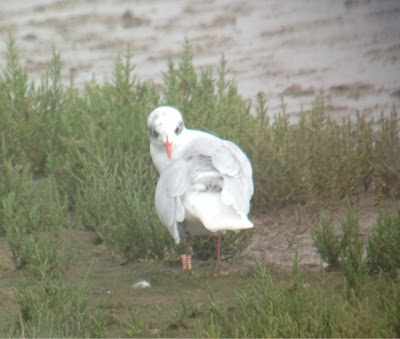"The early part of the year was quiet, with most of my time spent improving the habitat on site. Last year's clearance around the bird feeders continued to improve the catches of finches and Lesser Redpoll, Siskin, Brambling and last year's Cirl Bunting were all caught in the first few months of the year.
Every year has its quiet times and if you're lucky a few purple patches. During spring 2013, the purple patches were few in number, with winter dragging on well into spring. In late March, the wind turned southeast and many birders noticed large numbers of Chiffchaffs in the far southwest of Britain. On 25th March, my nets were opened and 118 Chiffchaffs caught, two of which were controls: DLL278 was ringed at Icklesham (East Sussex) on 18/9/2010 and EKX125 was ringed at Portishead (Somerset) on 1/7/2012. Soon after, details of three more controls were received and gave a further indicator that most of the birds involved were destined for southern Britain. EPL449 was ringed at Nanjizal on 30th March and found dead at Crew (Somerset) on 1/5/13, another ringed on 26th March was controlled a few weeks later at Slapton Ley (Devon), and another ringed during the same period on Skokholm (Dyfed) stayed to breed at Nanjizal instead of heading back further north.
Compare this to the spring of 2011, when prolonged periods of southeasterly winds brought larger numbers of abietinus Chiffchaffs than usual and in amongst them were two interesting controls. One ringed at Sul Panaro, Italy, on 2/10/2009 and controlled on 4/5/2011 and another ringed at Giessen, Germany, on 26/9/2010 and controlled at Nanjizal on 7/4/2011.
Spring/summer 2013 didn't produce any further noticeable falls, just the odd surprise turning up in a net; the most surprising being a female Subalpine Warbler caught on 5th July.
After last year's poor breeding season, it was nice to be catching good numbers of young birds on CES and most species seem to have done OK, with both Sedge Warbler and Dunnock doing very well, and only Blackcap having a poor year. See below the numbers of young birds ringed of selected species during the whole CES season in 2012 and to the end of July only in 2013.
| Year | 2012 | 2013 |
|---|---|---|
| Dunnock | 39 | 34 |
| Wren | 37 | 62 |
| Sedge Warbler | 26 | 39 |
| Whitethroat | 3 | 11 |
| Chiffchaff | 115 | 98 |
| Blackcap | 15 | 6 |
For the first time I have used tapes at Nanjizal this autumn and my change
of heart came with the chance of purchasing cheap, small MP3 players with decent rechargeable batteries. Once the
CES visits were completed I started to play Grasshopper Warbler just before sunrise and I am sure other people have noticed that Gropper tapes also work very well for Sedge
Warbler: I later found that you can pretty much play any warbler and other
species will respond. Up to 24th September,
I have now ringed a surprising total of 53 Grashopper Warblers!
Further confirmation of a good breeding season for Sedge Warblers sees my annual total now over 500, a high percentage
of which were trapped around the Gropper tape. An Aquatic Warbler also seemed to find
it appealing on the 20th, only the second bird seen in the UK this autumn!
Until last week, numbers of Blackcap had been unusually
low, but they have now arrived en masse and the 20th alone saw 98 being ringed, bringing my annual total over the 400 mark. As well as the large numbers of birds, the
last few ringing sessions have produced the afore-mentioned Aquatic, Marsh Warbler (22nd) and a Wryneck (24th). A
few recoveries have also come in over the last few weeks and the Skokholm-ringed
Chiffchaff reappeared in a net a few days ago."








.jpg)
